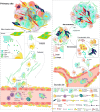Pro-tumorigenic functions of macrophages at the primary, invasive and metastatic tumor site
- PMID: 32500231
- PMCID: PMC11027658
- DOI: 10.1007/s00262-020-02616-6
Pro-tumorigenic functions of macrophages at the primary, invasive and metastatic tumor site
Abstract
The tumor microenvironment (TME) not only facilitates cancer progression from the early formation to distant metastasis, but also it differs itself from time to time alongside the tumor evolution. Tumor-associated macrophages (TAMs), whether as pre-existing tissue-resident macrophages or recruited monocytes, are an inseparable part of this microenvironment. As their parents are broadly classified into a dichotomic, simplistic M1 and M2 subtypes, TAMs also exert paradoxical and diverse phenotypes as they are settled in different regions of TME and receive different microenvironmental signals. Briefly, M1 macrophages induce an inflammatory precancerous niche and flame the early oncogenic mutations, whereas their M2 counterparts are reprogrammed to release various growth factors and providing an immunosuppressive state in TME as long as abetting hypoxic cancer cells to set up a new vasculature. Further, they mediate stromal micro-invasion and co-migrate with invasive cancer cells to invade the vascular wall and neural sheath, while another subtype of TAMs prepares suitable niches much earlier than metastatic cells arrive at the target tissues. Accordingly, at the neoplastic transformation, during the benign-to-malignant transition and through the metastatic cascade, macrophages are involved in shaping the primary, micro-invasive and pre-metastatic TMEs. Whether their behavioral plasticity is derived from distinct genotypes or is fueled by microenvironmental cues, it could define these cells as remarkably interesting therapeutic targets.
Keywords: Metastasis; Primary tumor; Pro-tumorigenic functions; Therapeutic targets; Tumor microenvironment; Tumor-associated macrophages.
Conflict of interest statement
The authors declare that they have no conflict of interest.
Figures



References
Publication types
MeSH terms
LinkOut - more resources
Full Text Sources
Medical
Research Materials

